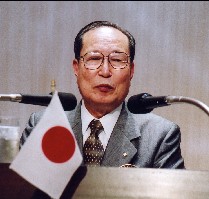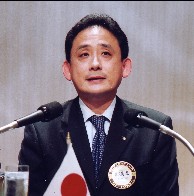Initiation Speeches
April 27th, 2005
Mr.Tsunehiko Yui
Mr. Toru Sakuma
 Management in Japan
Management in Japan
Executive Director of the Mitsui Library
Mr.Tsunehiko Yui
My academic specialty is the history of business management and unlike the macro view of economic history which encompasses population, income, prices, etc., it is a micro study of development of managerial activities, entrepreneurs and reform, management strategies and organization, ethics and principles are the matter we take up for study, and we come under the classification of ��Management Studies��.
Today, I wish to speak on ��Business Leaders in Japan�� ranging from the Taisho Period (1919��25) up to the year before the war as seen from an international viewpoint.
Many of you are today��s business leaders, but I wish to speak about a time in which Japan's large corporations were just getting started, and this from an international standpoint.
The first half of the 20th century saw the growth of major corporations in the world. The same happened in Japan. Whereas we take our business leaders of the time for granted, seen from an international viewpoint, they were business leaders with a unique Japanese characteristic.
In America, people such as Gary of US Steel, Coffin of GE and Sloan of General Motors represent this class, but their careers were quite different from their Japanese counterparts. They were not the products of elite universities, nor did they start at the bottom and work themselves up.
For the Japanese, they had long careers as the Executive Director of their company, and they were well known for their work. The American managers had worked for several other companies, and had emerged because of mergers.
Gary in US Steel and Coffin in Electric manufacture had succeeded in completing mergers and risen to the top. Such people were thus professional executives.
Just as professional ball players do, they moved from firm to firm rising in esteem and power.
In England, it differed, and people such as the banker Sir R. McKenna, Sir A. Mont. and Sir Coutours who disliked being called a professional manager and were more active in politics, belonging to the nobility.
Many were graduates of the Ox��Bridge colleges which resembled Japan.
At the time, Japanese business leader were misunderstood by their counterparts in the West. Dan was an international person, having graduated from MIT.
He always complained that the relations between labor and management were unruffled in Japan as he too, had come up the ranks.
Today, in the post war years the world has become globalobalized and communications have improved between the managements of other countries, bringing us closer together. Yet, there is no denying that our DNA��s differ.
 Manufacturing Foodstuffs
Manufacturing Foodstuffs
Executive Director of Tokyo Meiraku Ltd.
Mr. Toru Sakuma
My classification is, production of dairy products but I think the category ��Daily Foods�� is more appropriate.
Our tradition is to receive your order today, make it today and deliver it to you today.
In Japan, there has been a belief that ��There is no depression in the food industry��, but with fewer children and an ageing society it is said that with a reduced number of people or younger age several years later the consumption of foodstuffs will be greatly reduced. In other words, the generation which consumes double the amount of others will diminish rapidly.
With an old age generation increasing, it is said that life science industries with foodstuffs at its center is a growth industry.
As symbolized by the saying, ��food and medicine have the same roots�� and the availability of a more varied menus the importance of food will become more important from the standpoint of health and living.
With such a leaping growth in the amount of interest and information available the possibilities for growth is possible. On the other hand, the BSE issue, transfer of DNA, false reporting and markings have become large issues reported by the media.
To secure the safety of foodstuffs, and obtain consumer confidence we must tighten our operations but this is causing a heavy burden to be borne by especially our middle ranking food producers.
Our consumers today are becoming polarized between those who have a wealth of information, and those who lack the same. Those who know can choose from a wide field those articles which can aid their health and nutrition. On the other hand, especially for working females are attracted to instant foods and foods meeting their tastes, which causes dietary irregularities among our youth and also illnesses among our aged.
This is why our government lately has been stressing the importance of educating our people regarding their dietary habits. Hitherto such efforts targeted growing children, but today the same effort is being made for our senior people.
Our foodstuff industry must meet the demands of our customers by providing what they wish, when they wish and where they wish while making food which is healthy, simple to prepare and unique in quality.
There is an unchanging belief that ageing is an illness which can be treated by diet. Outside of hereditary traits, obesity and oxidization are the major reasons for ageing.
Thus one should eat green vegetables, beans, and mushrooms of every type aggressively. Oils and fats should be avoided, and large amounts of pure water should be taken also, peppers, garlic and vegetable fibers are also effective for health.
However, stating these facts on markings, may violate pertinent laws, so we live in a difficult industry.